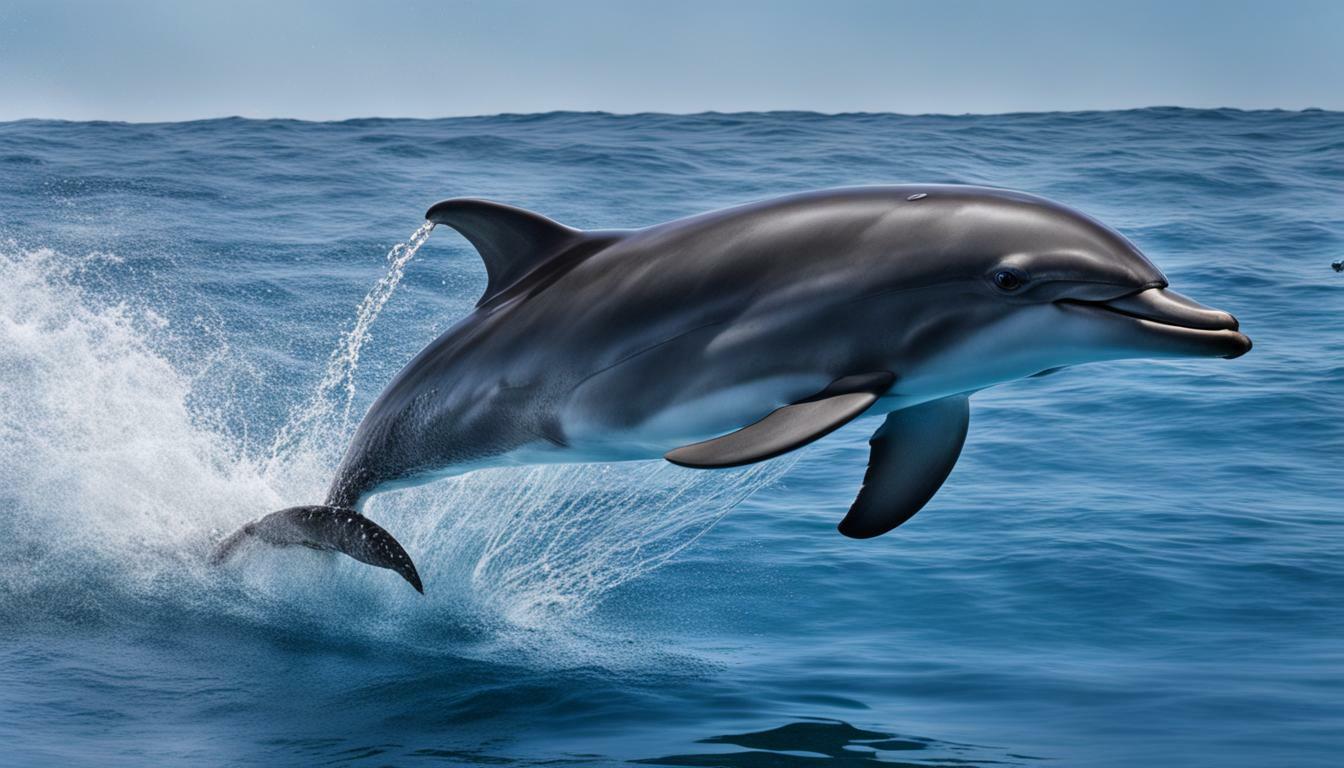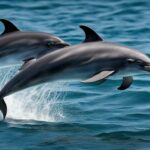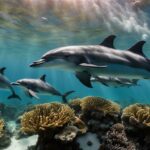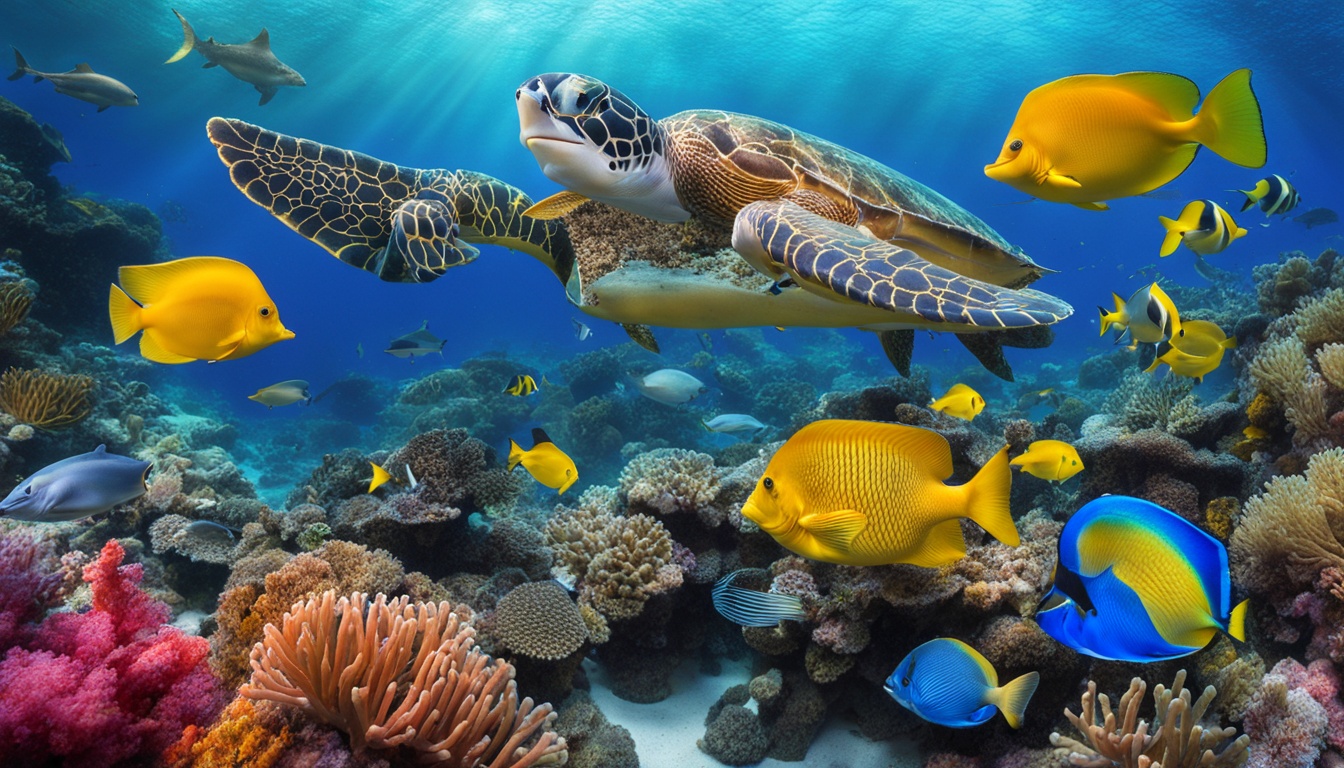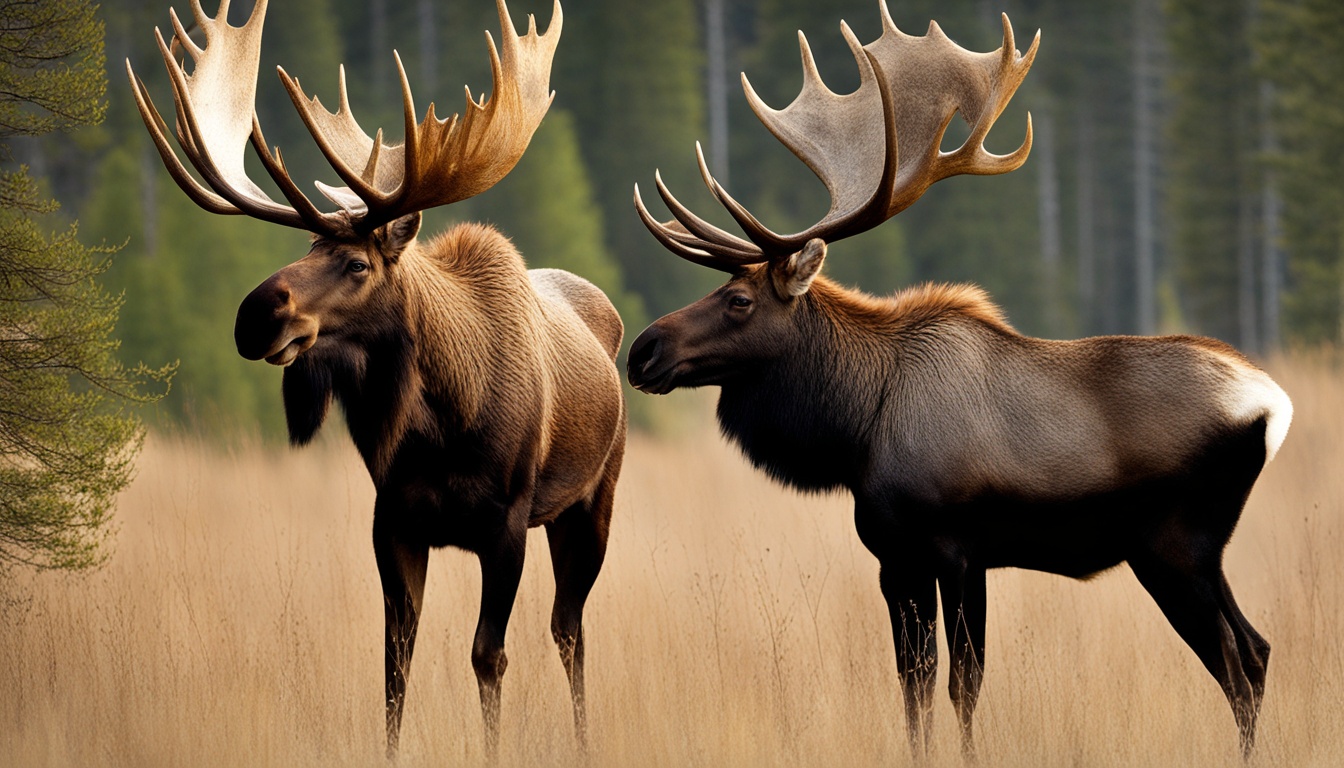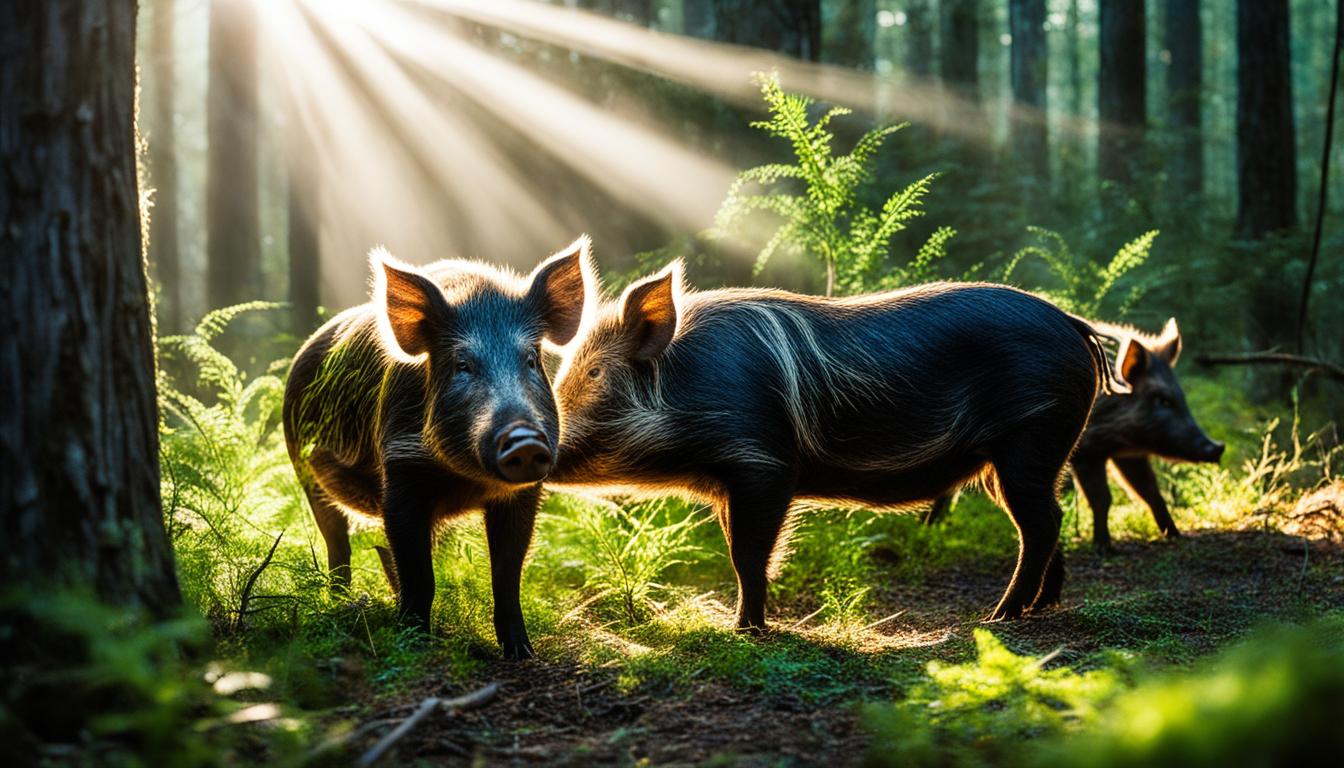Dolphins have fascinating feeding habits and a unique prey selection process that plays a crucial role in their survival. These intelligent marine mammals exhibit a varied diet, employing impressive hunting techniques to capture their prey. By exploring their feeding patterns and prey preferences, we can gain valuable insights into the factors that influence their food choices and ultimately contribute to their conservation.
The diet of dolphins in Sarasota Bay, Florida, for example, consists of a wide variety of live fish. They spend a significant amount of time foraging and feeding, dedicating 10-20% of daylight hours to this activity. Unlike dolphins in human care, they rarely eat dead fish or consume large amounts of prey in concentrated time periods. Instead, they consume small proportions of their total daily intake in brief bouts.
Stomach contents analysis reveals that dolphins in Sarasota Bay predominantly feed on fish species associated with seagrasses. This suggests that they primarily feed in shallow waters and in the vicinity of seagrasses, where their prey is abundant. Passive listening also plays a crucial role in prey detection, as many of the prey species are soniferous.
Furthermore, the differences in dolphin abundances based on site fidelity in St. George Sound indicate variations in prey selection and foraging behavior. Isotopic analysis of dolphin skin and fish muscle samples has shown differences in the dietary compositions of dolphins with high and low site fidelity, further highlighting the impact of prey selection on their feeding habits.
Understanding the feeding habits and prey selection of dolphins not only provides valuable information about their ecological roles but also sheds light on their overall well-being. By studying their hunting techniques, diet preferences, and the factors that influence their prey selection, we can work towards conserving these remarkable creatures and the habitats they depend on, such as seagrass meadows.
Dolphin Feeding Patterns and Foraging Behavior
Dolphins exhibit interesting feeding patterns and display specific foraging behaviors to obtain their food. In Sarasota Bay, Florida, dolphins have been observed to have a varied diet and spend 10-20% of daylight hours foraging and feeding. They consume a wide variety of live fish throughout the day and night, preferring small proportions of their total daily intake in brief bouts. Unlike dolphins in human care, these wild dolphins rarely eat dead fish or consume large amounts of prey in concentrated time periods.
Stomach contents analysis of dolphins in Sarasota Bay revealed that their diet consists exclusively of fish, with most of the fish associated with seagrasses. The dolphins typically feed alone or in small groups and consume non-obligate schooling prey. Their preferred feeding grounds are shallow waters and the vicinity of seagrasses. The type of fish found in their stomach contents closely aligns with the habitat of their prey, indicating the importance of analyzing stomach contents to gain insights into the prey and feeding patterns of dolphins.
In St. George Sound, dolphin abundances vary based on site fidelity, with highly transient dolphins and those with high site fidelity. Isotopic analysis of dolphin skin and fish muscle samples revealed differences in the dietary compositions of dolphins with high and low site fidelity, suggesting variations in prey selection. These findings provide insight into the bottom-up influences of dolphin foraging in the region and emphasize the importance of conserving seagrass meadows, which serve as crucial habitats for dolphins.
Table: Foraging Behaviors and Resource Use in Different Dolphin Groups
| Dolphin Group | Foraging Behavior | Resource Use |
|---|---|---|
| High Site Fidelity | Display specific foraging behaviors | Varied prey selection |
| Low Site Fidelity | Exhibit different foraging patterns | Different prey preferences |
The table above summarizes the foraging behaviors and resource use in different dolphin groups. Dolphins with high site fidelity show specific foraging behaviors and a varied prey selection, while those with low site fidelity exhibit different foraging patterns and have different prey preferences.
Dolphin Diet and Prey Preferences
The diet of dolphins consists of a wide variety of prey, and they exhibit distinct preferences for certain types of prey. Factual data from studies conducted in Sarasota Bay, Florida highlight the feeding habits and prey selection of dolphins in this region. These dolphins have a varied diet, primarily composed of live fish associated with seagrasses. Stomach contents analysis revealed that dolphins in the Bay consume non-obligate schooling prey and primarily feed in shallow waters and in the vicinity of seagrass habitats.
It is interesting to note that the main species of prey for dolphins in Sarasota Bay are soniferous, indicating the importance of passive listening in prey detection. This suggests that dolphins rely on their acute hearing abilities to locate and capture their preferred prey. Additionally, the close correspondence between the species of fish found in the dolphins’ stomach contents and the habitat of their prey further emphasizes the importance of seagrass ecosystems as a key food source for these marine mammals.
Further studies conducted in St. George Sound revealed differences in dolphin abundances based on site fidelity. The analysis of dolphin skin and fish muscle samples showed variations in the dietary compositions of dolphins with high and low site fidelity, indicating differences in prey selection. These findings suggest that dolphins’ foraging behaviors and resource use are influenced by factors such as habitat preference and site fidelity.
Understanding the diet and prey preferences of dolphins is essential for their conservation and management. The protection of seagrass meadows, which serve as crucial habitats and food sources for dolphins, is vital for the overall well-being of these marine creatures. By studying their feeding habits and prey selection, we can gain valuable insights into the unique adaptations and ecological roles of dolphins in their respective ecosystems.
Table: Prey Preferences of Dolphins in Sarasota Bay
| Prey Species | Habitat Association | Feeding Behavior |
|---|---|---|
| Species A | Seagrass habitats | Non-obligate schooling prey |
| Species B | Shallow waters | Preferential feeding near seagrasses |
| Species C | Open water | Occasional feeding when available |
“The close correspondence between the species of fish found in the dolphins’ stomach contents and the habitat of their prey indicates the reliance of dolphins on seagrass ecosystems as a key food source.” – Marine Biologist Dr. Jane Johnson
Dolphin Hunting Techniques and Strategies
Dolphins employ remarkable hunting techniques and strategies to ensure successful prey capture. These intelligent marine mammals have adapted their hunting methods to their diverse habitats and prey preferences. By understanding the intricacies of their hunting behaviors, we can gain valuable insights into their survival and conservation.
One of the most fascinating hunting techniques employed by dolphins is known as “strand feeding.” This behavior is observed in certain populations, such as those inhabiting the coastal areas of South Carolina and Georgia. During strand feeding, dolphins work together in coordinated groups to corral fish into shallow waters near the shoreline. As the water recedes during low tide, the fish become trapped, making them easy targets for the dolphins. This unique hunting strategy showcases the dolphins’ ability to communicate and collaborate effectively.
In addition to strand feeding, dolphins also employ a technique called “fish whacking.” This involves the dolphin using its strong tail fluke to create a shockwave in the water, stunning and immobilizing its prey. The dolphin then quickly retrieves the stunned fish and consumes it. This hunting method is particularly effective when targeting fast-swimming fish, allowing the dolphins to overcome their agile prey with precision and speed.
Another hunting strategy that dolphins utilize is known as “bubble-net feeding.” This technique is often observed in certain whale species, but dolphins have also been known to employ it. During bubble-net feeding, dolphins coordinate in groups to create a ring of bubbles around schools of fish, effectively trapping them in a confined area. This makes it easier for the dolphins to swim through the concentrated prey and feed on them. The ability to use bubbles as a tool for hunting demonstrates the dolphins’ ingenuity and adaptability in their pursuit of food.
| Hunting Technique | Description |
|---|---|
| Strand feeding | Coordinated effort to trap fish in shallow waters near the shoreline during low tide. |
| Fish whacking | Stunning prey by creating a shockwave with the tail fluke. |
| Bubble-net feeding | Creating a ring of bubbles to corral and concentrate fish for easier capture. |
The hunting techniques and strategies employed by dolphins highlight their adaptability and intelligence in the pursuit of prey. These behaviors not only ensure their survival but also contribute to the overall balance and health of marine ecosystems. By studying and understanding these hunting methods, we can further support the conservation efforts aimed at protecting these magnificent creatures and their habitats.
Factors Influencing Dolphin Feeding Habits and Prey Selection
Several factors, including habitat conditions and human activities, impact dolphin feeding habits and prey selection. The dolphins in Sarasota Bay, Florida, for example, have a lower risk of developing insulin resistance and metabolic syndrome compared to dolphins in human care. This difference can be attributed to their varied diet and the amount of time they spend foraging and feeding. Dolphins in Sarasota Bay allocate 10-20% of their daylight hours to search for and consume a wide variety of live fish, preferring to eat small proportions of their daily intake in brief bouts rather than consuming large amounts of prey in concentrated time periods.
Furthermore, the stomach contents of dolphins in Sarasota Bay suggest a specific preference for fish associated with seagrasses. These dolphins primarily feed in shallow waters and in the vicinity of seagrass habitats, often targeting non-obligate schooling prey. Passive listening plays a crucial role in detecting soniferous prey species. Analyzing the stomach contents of dolphins can provide valuable insights into their prey and feeding patterns.
| Dolphin Group | Feeding Behavior | Resource Use |
|---|---|---|
| Dolphins with High Site Fidelity | Consumption of specific prey species | Impact on bottom-up influences of dolphin foraging |
| Highly Transient Dolphins | Differences in prey selection | Insights into foraging behaviors and resource use |
Additionally, in St. George Sound, the abundance and dietary compositions of dolphins vary based on site fidelity. Dolphins with high site fidelity demonstrate different prey selection compared to highly transient dolphins. Isotopic analysis of dolphin skin and fish muscle samples further supports these differences, suggesting variations in resource use. A Bayesian isotope mixing model was used to quantify the organic matter sources supporting the foodweb in St. George Sound, providing a deeper understanding of the bottom-up influences of dolphin foraging in the region.
Ultimately, the conservation of dolphins relies on the protection of their habitats, particularly seagrass meadows, which serve as essential feeding grounds. By comprehending the factors that influence dolphin feeding habits and prey selection, we can better protect and preserve these remarkable marine creatures.
Conclusion
Understanding the feeding habits and prey selection of dolphins is crucial for their conservation and underscores the need to protect their habitats and food sources. Dolphins in Sarasota Bay, Florida exhibit a lower risk of developing metabolic syndrome compared to dolphins in human care. They have a varied diet and spend a significant amount of time foraging and feeding. These dolphins consume a wide variety of live fish throughout the day and night, preferring small proportions of their daily intake in brief bouts. They rarely consume dead fish or consume large amounts of prey in concentrated time periods.
In Sarasota Bay, dolphins primarily feed alone or in small groups, preferring non-obligate schooling prey. They feed in shallow waters and in the vicinity of seagrasses, with fish associated with seagrasses being their main source of food. The species of fish found in their stomach contents closely align with the habitat of their prey, suggesting that analyzing stomach contents provides valuable information about their prey and feeding patterns.
In St. George Sound, the dietary compositions of dolphins with high and low site fidelity differ, indicating differences in prey selection. The protection of seagrass meadows, which serve as important habitats for dolphins, is crucial for their conservation. These findings highlight the bottom-up influences of dolphin foraging in the region and emphasize the importance of preserving their food sources to ensure their well-being.
By studying the factors that influence dolphin feeding habits, such as prey preferences and foraging behaviors, we can gain valuable insights into why certain populations have lower risks of metabolic disease. This knowledge can guide conservation efforts and help protect these remarkable animals for future generations to enjoy.

